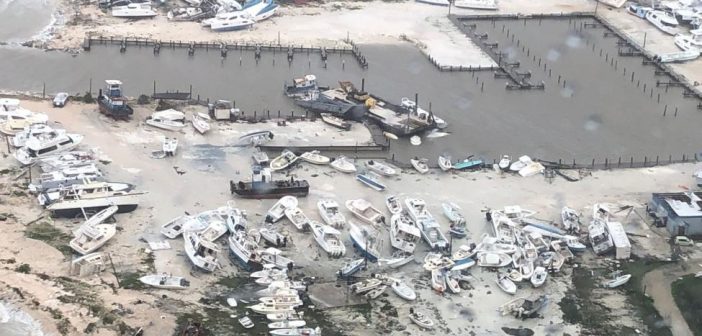In a truly inspiring display of caring for their fellow human beings, friends and strangers alike, hundreds of boat owners have rallied to provide aid to people in the Bahamas whose lives were devastated by Hurricane Dorian a month ago. The storm’s historic winds, with sustained speeds of 185 mph, destroyed entire towns and villages in the Abacos, leaving 15,000 people homeless. Marsh Harbour was particularly hard hit. “It was pure hell,” one survivor said. Others said they survived by tying themselves to trees.
As of this week, 600 people are still missing and 56 have died. Hubert Minnis, the Bahamian Prime Minister, told the United Nations that many more people have probably died and not been found “because the rising tide, then receding ocean water, swept away young and old with their homes.”
In an age of rapidly changing news cycles, we tend to forget what happened yesterday or last week, even though the dead are still dead, and thousands of the living are still suffering, without homes, jobs or medical care. But we need to remember the acts of hundreds, if not thousands, of boat owners and others who rushed to their aid as fast as they could.
So many small boats left Florida just after the hurricane that people were comparing them to the “little ships” that crossed the English Channel to save the British Army at Dunkirk. There were so many that the Coast Guard started turning them back; it was worried that it would have to divert resources to saving them if they ran into trouble crossing the Gulf Stream.
But the fleet of boats from Miami, Fort Lauderdale, Palm Beach and Pompano, in particular, grew and continued, providing a vital lifeline to the most hard-hit islands. More than 30 boats loaded with supplies left Pompano in the early days, for example, organized by a group called the Offshore Anglers of Pompano Beach; at first they went 90 miles to West End, where the marinas were still functioning, before later heading farther into the stricken areas.
Floridians have an affinity for the Bahamas. Many Florida boaters cruise or fish there regularly. They have friends, there, even relatives. “Abaco and the islands are like family to us,” said Phil Purcell, president of the Marine Industries Association of South Florida.
For Duane Kuck, the CEO of Regal Marine, the link to the Bahamas is personal. The father of his wife, Cindy, was born and raised on Man-O-War Cay in the Abacos. Her cousin, Troy Cornea, owned the Harbour View Marina and Wally’s restaurant; they were destroyed. Two days after the hurricane, Kuck, who’s a pilot, and some friends hired two helicopters to rescue people from the most hard-hit islands. They got 20 on the first day, and then continued flying to Elbow Cay, Man-O-War, Green Turtle, Treasure and Marsh Harbour.
Various organizations dropped off food and medical supplies at Sanford airport; they were then flown to the airport at North Eleuthera, where small boats ferried them to Marsh Harbour.
The boats leaving Florida ranged from center consoles to megayachts. Brad and Lorraine Carlton loaded their Nordhavn 55 Adventure and headed across the Stream to help. Organizations including Yacht Aid Global, CBS Bahamas, Sol Relief, World Hope International and the National Emergency Management Association in the Bahamas created Operation Topaz to supply relief. Loon, a 155-foot Christensen superyacht, became a flagship of support, taking supplies to Marsh Harbour. It stayed there a week supplying water from its onboard desalination plant.
Carl Allen, the Texas billionaire, used his 164-foot superyacht Gigi to carry supplies to Walker’s Cay, where smaller boats picked them up for redistribution. The 240-foot Laurel carried construction materials and food from Florida, later rescuing 240 dogs from Marsh Harbour.
After a week or so, the airport at Marsh Harbour reopened to larger flights, taking some of the pressure off the boat conveys. But the suffering continued. Indeed, forensics teams in white-hooded jumpsuits were looking for bodies trapped in a collapsed church there. Read more:
https://www.newyorker.com/news/dispatch/a-haphazard-recovery-in-the-bahamas




